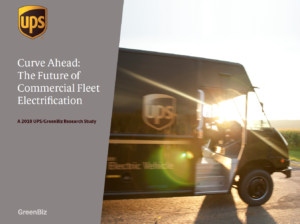Attaining environmental benefits and lower cost of ownership are driving more US commercial fleets to electrify, according to a UPS and GreenBiz study. In the “Curve Ahead: The Future of Fleet Electrification” report, industry leaders identify the main motivations and barriers to electrification, as well as strategies to move the commercial electric vehicle market from niche to mainstream.
Motivation
The top motivation to go electric for 83 percent of large US businesses surveyed is sustainability and environmental goals. A lower total cost of ownership, factoring in both direct and indirect costs and savings over the life of the vehicle, is the second biggest driver, cited by 64 percent of respondents. In addition to the fuel savings, electric vehicles (EVs) typically require less maintenance than traditional internal combustion engine vehicles, which means lower maintenance costs.
Barriers
The study revealed several key findings from large US companies and government agencies, including:
- The primary motivators for electrifying fleets are achieving sustainability goals (83 percent of respondents) and lowering total cost of ownership (64 percent).
- The top barriers are a prohibitive initial purchase price (55 percent), lack of EV charging infrastructure at facilities (44 percent) and lack of product availability of EV’s (35 percent).
- 92 percent of respondents indicated that their organization is not well-equipped with onsite EV charging infrastructure for commercial vehicles.
- There is an opportunity for businesses to work together with suppliers, government and utilities. A 70 percent of survey respondents indicated that they collaborate with suppliers but less than half currently collaborate with government or with utilities.
UPS London
“The challenges of cost and infrastructure requirements can be daunting, but we’ve begun to see solutions emerge,” said Scott Phillippi, UPS senior director of automotive maintenance and engineering. “In the U.S., we recently ordered 50 electric-powered delivery trucks that we anticipate will be at cost parity with conventional diesel-powered vehicles. And in London, we were able to find a solution for our charging needs through a collaboration between government and private organizations. The business case, combined with a growing preference for EVs from cities and national governments, will help us to reach a tipping point to large-scale EV fleet adoption.”
Fleet managers and industry experts interviewed suggested strategies to overcome such challenges, including starting small. Instead of undertaking a large-scale fleet overhaul, many companies will prioritize electric options when replacing vehicles and even consider electric leasing options to mitigate the initial purchase price. Converting from internal combustion engines to electric depends on specific vehicle uses, the size and distribution of fleets across regions, the costs of electricity and access to charging infrastructure.
“Despite the complexity of transitioning commercial fleets to an electric future, the vehicle technologies and options to upgrade infrastructure are quickly improving,” said Paul Carp, GreenBiz Group’s director of research and senior analyst. “Continued industry collaboration will be critical to accelerate fleet electrification across a wide range of use cases.”
UPS: practice what you preach
As the market for electric commercial vehicles matures, 70 percent of companies report working closely with vehicle manufacturers and suppliers to identify the latest electric vehicle technologies and features. This communication is important given 32 percent of survey respondents cited inadequate product availability as a barrier. UPS is working with commercial vehicle manufacturers such as ARRIVAL, Tesla, Thor Trucks, and Workhorse, providing data and performance feedback to help foster product availability and create fleet solutions that fit its unique needs.
UPS also works with manufacturers, governments, and utilities to leverage innovative technology, such as smart grid charging in London that enables the company’s electric-vehicle fleet to charge without an expensive power supply grid update. The project, made possible by engaging UK Power Networks, Cross River Partnership and UK’s Office for Low Emissions Vehicles, is an example of how collaboration can overcome vehicle electrification barriers.
Source: UPS


[…] and UPS aren’t alone in facing these challenges. A recent study by UPS and GreenBiz showed that the high prices for electric vehicles, inadequate charging networks and a lack of […]